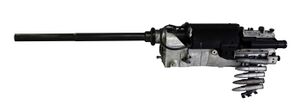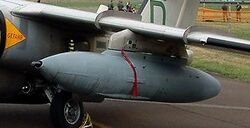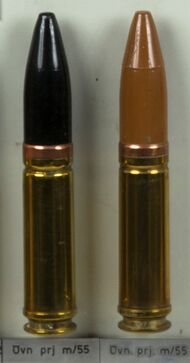Engineering:ADEN cannon
| ADEN cannon | |
|---|---|
 30 mm ADEN Mk 4 on display at the Imperial War Museum Duxford | |
| Type | Revolver cannon |
| Place of origin | United Kingdom |
| Service history | |
| Used by | See users |
| Production history | |
| Designer | Armament Development Establishment |
| Designed | 1946 |
| Manufacturer | Royal Small Arms Factory |
| Produced | 1953–present |
| Specifications | |
| Mass | 196 kg (432 lb) with 200 rounds |
| Length | 1,590–1,639 mm (5 ft 2.6 in–5 ft 4.5 in)[1] |
| Barrel length | 1,080 mm (3 ft 7 in)[1] |
| Shell | 30×111mm belted[2][3] |
| Calibre | 30 mm (1.2 in) |
| Action | gas operated revolver |
| Rate of fire | 1,200–1,700 rpm |
| Muzzle velocity | 795 m/s (2,610 ft/s) |
The Royal Small Arms Factory ADEN cannon (ADEN being an acronym for "Armament Development, Enfield")[4] is a 30 mm revolver cannon used on many military aircraft, particularly those of the British Royal Air Force and Fleet Air Arm.[5] Developed post-World War II primarily to meet British Air Ministry's requirement for increased lethality in aircraft armament, the cannon was fired electrically and is fully automatic once it is loaded.[6]
Design and development

During World War II, the German firm Mauser began development of a radically new 20 mm autocannon using a motorised firing mechanism in order to improve the rate of fire. The weapon was designed for 20mm mine shell rounds (designated the Mauser MG 213 and for 30mm rounds (the Mauser MK 213). However, production of the MK 213 never commenced due to development problems such as excessive barrel wear, not to mention the Allied Combined Bomber Offensive campaign against German industry.[7] At the end of the war only 5 prototypes (V1 to V5) of either 20 mm MG 213 or 30 mm MK 213 were finished.[7]
In the post-war era, the MK 213 became well known in armament circles, and a number of companies took up development. This included the Armament Development Establishment in the UK and GIAT in France. A common 30×111mm round[2][3] was developed that offered a dramatic improvement in muzzle velocity from the MK 108's 540 m/s to the new design's 790 m/s (2,600 ft/s). This was only slightly lower than contemporary 20 mm cannon like the Hispano Mk. V's 840 m/s (2,800 ft/s), making the new round suitable for use during dogfights as well as against larger targets. The mechanism improved the rate of fire from the Mk. V's 750 rpm to 1,300 rpm, a significant improvement.[1] The new weapon was quickly developed and production was set up at the Royal Small Arms Factory in Enfield. The name ADEN was created by combining the two first initials of Armament Development Establishment with the first two letters of Enfield, producing ADEN.[2]
The ADEN cannon entered service on the British Hawker Hunter in 1954, and was subsequently used on every British gun-armed aircraft until the advent of the Panavia Tornado in the 1980s.[5] The last version to see production was the Mk. 4. An improved version, the Mk. 5, incorporates a multitude of small changes to improve reliability and increase rate of fire to 1,500–1,700 rounds per minute. No new Mk 5s were built, but many older weapons were converted, being redesignated "Mk 5 Straden".[1]
GIAT also introduced their version of the design as the DEFA cannon; the two weapons are very similar.[5]
ADEN 25
The ADEN Mk 5 became the basis for the planned ADEN 25, which was to be a somewhat larger weapon at 90 in (2.3 m) long and weighing 203 pounds (92.1 kg) firing the new range of 25x137mm NATO STANAG 4173 ammunition (as developed for M242 Bushmaster) at a much higher muzzle velocity of 3,445 feet per second (1,050 m/s). The lighter ammunition was also to produce a higher rate of fire, 1,650 to 1,850 rounds per minute. The ADEN 25 was selected for British Harrier GR.5 aircraft. After initial weight issues and persistent problems integrating the cannon with the pod, and the pod with the Harrier GR.5 aircraft, the MoD considered the cost of fixing the problems excessive.[8] and the project cancelled in 1999. As a result, RAF Harrier GR.7 and GR.9 aircraft did not carry a cannon, no attempt apparently having been made to retrofit the older ADEN 30 mm pods. Fleet Air Arm BAE Sea Harriers retained the 30 mm weapon until their retirement in 2006.
Aircraft use
Built-in armament

- CAC Sabre
- English Electric Lightning
- Folland Gnat
- Gloster Javelin
- HAL Ajeet
- Hawker Hunter
- Saab Draken
- Saab Lansen
- SEPECAT Jaguar
- ST Aerospace A-4S Skyhawk
- Supermarine Scimitar
- Supermarine Swift
As external armament

The ADEN gun has seen use in several gun pods including:
- British Hawker Siddeley Harrier and BAe Sea Harrier, as well as the US Marine Corps AV-8A/Cs, carried two 30 mm ADEN gun pods below the fuselage of the aircraft.
- The FFV 30 mm and Matra SA-10 gunpods produced for Swedish Air Force by collaboration with FFV and S. A. Engins Matra used on Saab AJ 37 and Saab Sk 60B/C attack aircraft during the early 1970s used guns taken from scrapped Swedish Saab J 32Bs and Hawker Hunter J 34s. The FFV pod has also been sold to the Austrian Air Force for use on their Saab 105Ös.
- A centreline gun pod containing ADEN gun and 100 rounds on the BAE Systems Hawk in RAF service. It is still in active service with, among others, the South African Air Force .[9]
Specifications
The Aden is belt feed using a disintegrating belt of open type links.
- Type: Single-barrel aircraft autocannon
- Action: Revolver drum with 5 chambers[10]
- Operation: Gas operation[1]
- Cocking-system: Pneumatic[1]
- Priming: Electronic firing[1]
- Firing-system: Electrical 26 volts DC
- Rifling: Progressive RH parabolic twist, 16 grooves[1]
- Cartridge: 30 × 111 mm[2][3]
- Calibre: 30 mm (1.18 in)
- Weight of complete weapon: 87.1 kg (192 lb), 196 kg (432 lb) with 200 rounds[5]
- Length of complete weapon: 1,590–1,639 mm (5 ft 2.6 in–5 ft 4.5 in)[1][10]
- Weight of barrel: 12.25 kg (27.0 lb)[1]
- Length of barrel: 1,080 mm (3 ft 6.5 in)[1]
- Recoil load: 31.4 kN
- Rate of fire: 1,200–1,500 rpm (ADEN Mk. 4),[10] 1,500–1,700 rpm (ADEN Mk.5)
Ammunition

30 mm mgr m/55[lower-alpha 1]

30 mm övnprj m/55[lower-alpha 2]
Ammunition for the ADEN included.[2][3]
- High Explosive (High Explosive Mk.3Z[lower-alpha 3] [3])
- Projectile type: "High-Explosive, High-Capacity"[11]
- Fuze type: Nose fuze[11]
- Explosive filling: 52.5 g (1.85 oz)[10] Torpex 5[3] (Hexotonal)[11]
- Cartridge weight: 440 g (15.5 oz)[2]
- Projectile weight: 220 g (7.76 oz)[2]
- Propellant weight: 46 g (1.62 oz)[2]
- CU-pressure: 2930 bar[2]
- Muzzle velocity: 795 m/s (2,610 ft/s) [lower-alpha 4] [2]
- Armour-piercing (30 mm pprj m/55[lower-alpha 5] Sweden[2])
- Projectile type: Armour-Piercing, Composite Rigid[10]
- Fuze type: None[10]
- Core type: Tungsten penetrator[10]
- Cartridge weight: 511 g (18.0 oz)[2]
- Projectile weight: 270 g (9.52 oz)[2]
- Core weight: 150 g (5.29 oz)[10]
- Propellant weight: 47 g (1.66 oz)[2]
- CU-pressure: 2930 bar[2]
- Muzzle velocity: 795 m/s (2,610 ft/s)[lower-alpha 4][2]
- Target practice (Practice Mk.2Z[lower-alpha 6], UK )[3]
- Projectile type: Inert solid metal plug in place of fuze and explosive charge[11]
- Cartridge weight: 440 g (15.5 oz)[2]
- Projectile weight: 220 g (7.76 oz)[2]
- Core weight: 80.5 g (2.84 oz)[11][2]
- Propellant weight: 46 g (1.62 oz)[2]
- CU-pressure: 2930 bar[2]
- Muzzle velocity: 795 m/s (2,610 ft/s)[lower-alpha 4][2]
Users
 Australia
Australia
 Bahrain
Bahrain
 Belgium
Belgium
- Belgian Air Component
 Chile
Chile
 Denmark
Denmark
 Finland
Finland
 Iraq
Iraq
 India
India
- Indian Air Force
- Indian Naval Air Arm
 Indonesia
Indonesia
- Indonesian Air Force (TNI-AU)
 Jordan
Jordan
 Kenya
Kenya
 Kuwait
Kuwait
 Lebanon
Lebanon
 Netherlands
Netherlands
 Malaysia
Malaysia
 Oman
Oman
 Peru
Peru
 Qatar
Qatar
 Rhodesia (now
Rhodesia (now  Zimbabwe)
Zimbabwe)
- Royal Rhodesian Air Force (later to Air Force of Zimbabwe )
 Saudi Arabia
Saudi Arabia
 Singapore
Singapore
 South Africa
South Africa
 South Korea
South Korea
 Somalia
Somalia
- Somali Air Corps
 Spain
Spain
- Spanish Naval Air Arm
 Sweden
Sweden
- Swedish Air Force – designated 30 mm akan m/55
 Switzerland
Switzerland
 Thailand
Thailand
- Royal Thai Navy Flying Unit
 United Arab Emirates
United Arab Emirates
 United Kingdom
United Kingdom
- Fleet Air Arm
- Royal Air Force
Notes
- ↑ Full designation: 30 mm skarp patron m/55 mingranat m/55. Swedish production is painted yellow and British production is painted buff.[12][7]
- ↑ Full designation: 30 mm skarp patron m/55 övningsprojektil m/55. Early production is painted black and later production is painted brown.[12][7]
- ↑ Full designation: "Cartridge, 30mm, Aden gun, High Explosive Mk. 3Z"[3]
- ↑ 4.0 4.1 4.2 at 20 °C (68 °F)
- ↑ Full designation: 30 mm skarp patron m/55 pansarprojektil m/55[2]
- ↑ Full designation: "Cartridge, 30mm, Aden gun, Practice Mk. 2Z"[3]
See also
- Mauser BK-27 – comparable German design
- M39 cannon – comparable US design
- Oerlikon KBA - comparable Swiss design
- R-23 cannon – comparable Russian design
- VENOM LR 30 mm – 21st century derivative, designed to fire from RCWS
References
- ↑ 1.00 1.01 1.02 1.03 1.04 1.05 1.06 1.07 1.08 1.09 1.10 "ADEN 30 mm Cannon MK 4 & 5". United Kingdom: AEI Systems Ltd. Archived from the original on 2 January 2014. https://web.archive.org/web/20140102201822/http://www.aei-systems.com/wp-content/uploads/2013/09/Aden30mm-Mk456.pdf. Retrieved 4 February 2011.
- ↑ 2.00 2.01 2.02 2.03 2.04 2.05 2.06 2.07 2.08 2.09 2.10 2.11 2.12 2.13 2.14 2.15 2.16 2.17 2.18 2.19 2.20 2.21 2.22 AMKAT, Ammunitionskatalog, Data och bilder, Flygvapnet. Sweden: Försvarets materielverk, FMV. 1984.
- ↑ 3.00 3.01 3.02 3.03 3.04 3.05 3.06 3.07 3.08 3.09 3.10 Air Publication, 110L-0201-1, 30mm ammunition and fuzes, (Aden Gun), General and technical information. United Kingdom: Ministry of Defence, Prepared by the Ministry of Technology. 1970.
- ↑ "ADEN development". Flight (28 January 1955): 109. https://www.flightglobal.com/FlightPDFArchive/1955/1955%20-%200109.PDF. Retrieved 2021-05-27.
- ↑ 5.0 5.1 5.2 5.3 Lennox, Duncan (2001). "Guns: ADEN 30 mm cannon (United Kingdom)". Jane's air-launched weapons. Jane's Information Group. ISBN 978-0-7106-0866-6. http://www.janes.com/articles/Janes-Air-Launched-Weapons/ADEN-30-mm-cannon-United-Kingdom.html.
- ↑ "Aden 30mm Gun Installation". Hawker Hunter. http://www.hawkerhunter.com/6787/. Retrieved 4 February 2011.
- ↑ 7.0 7.1 7.2 7.3 Volume 2, Part 3, Hunter Weapons, The 30mm ADEN Gun, Rocket Projectiles, Air To Air Missiles, Bombs, etc.. pp. 2–6.
- ↑ ADEN Aircraft Cannon, http://www.forecastinternational.com/archive/disp_pdf.cfm?DACH_RECNO=1059
- ↑ "SAAF orders new Aden gun pod". 2011-03-23. https://www.defenceweb.co.za/aerospace/aerospace-aerospace/saaf-orders-new-aden-gun-pod/.
- ↑ 10.0 10.1 10.2 10.3 10.4 10.5 10.6 10.7 Saab 105, Flyghistorisk revy. Sweden: Svensk Flyghistorisk Förening. 2013. pp. 80, 81.
- ↑ 11.0 11.1 11.2 11.3 11.4 11.5 11.6 (in Swedish) Ammunitionsröjning, FV akanam. Data och bilder, Kursutgåva 1975. Sweden: Försvarets materielverk, Huvudavdelningen för flygmateriel, Vapenbyrån. 1975 (published 1975-05-21). p. 8.
- ↑ 12.0 12.1 Flygvapnets eldvapenammunition. Sweden: Försvarets materielverk, FMV. 1957.
External links
 |

